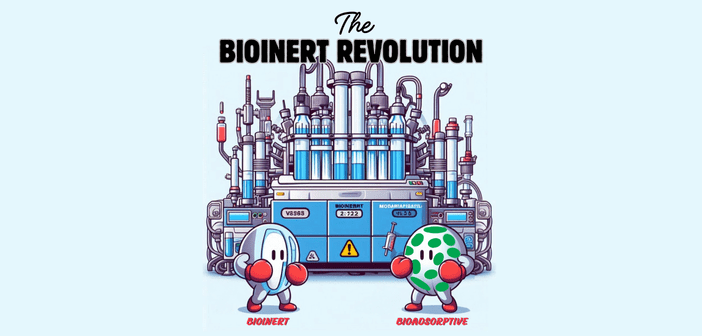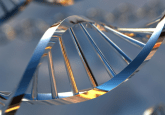The bioinert revolution

In Robert MacNeill’s (Pharmaron; PA, USA) latest column, he explores the recent remarkable advancements in LC–MS technology, driven by innovation to meet the evolving demands of the drug development industry. Robert specifically highlights the adoption of bioinert hardware, which is quickly gaining recognition for its value in improving the sensitivity and performance of chromatographic bioanalytical methods.
 Robert MacNeill received his BSc with Honors in Chemistry from Heriot-Watt University and then his MSc in Analytical Chemistry from the University of Huddersfield, both in the UK. Robert is also a Chartered Chemist and a Fellow of the Royal Society of Chemistry. With decades of experience in all aspects of quantitative bioanalytical LC–MS method development, many of these years heading bioanalytical method development activities in the CRO domain, and a regular author and speaker, Robert is a recognized expert and innovator in the field.
Robert MacNeill received his BSc with Honors in Chemistry from Heriot-Watt University and then his MSc in Analytical Chemistry from the University of Huddersfield, both in the UK. Robert is also a Chartered Chemist and a Fellow of the Royal Society of Chemistry. With decades of experience in all aspects of quantitative bioanalytical LC–MS method development, many of these years heading bioanalytical method development activities in the CRO domain, and a regular author and speaker, Robert is a recognized expert and innovator in the field.
In his current role, Robert is Director of Bioanalysis at Pharmaron in Exton (PA, USA). In addition to directorship duties, he coordinates the bulk of LC–MS method development, also keeps abreast of innovation and technological development in the industry, leading in-house research projects and managing the associated technical writing.
“We are very attached to our old systems.” – countless nucleic acids, peptides, proteins and small molecules throughout liquid chromatographic history.
There have been many impressive technological advances in LC–MS over the last few decades, showing terrific innovation and drive to meet the needs of the industry as the drug development landscape continues to evolve. One of the more recent introductions is that of bioinert hardware, and at this time it is rapidly becoming recognized as a wonderful asset, particularly for the chromatographic quantitative analysis of biologics, maximizing priceless methodological performance attributes like sensitivity. For many of us, it feels like it could rival even the elation over the Oasis reunion. It is thanks, fundamentally, to certain chemistries that effectively negate some dangerous interactions typically involving negatively charged or electron-rich molecular entities, that we have largely unwittingly tolerated forever. Hence the misfortune of witnessing people such as myself making frequent reference to the ‘bioinert bandwagon’. Indeed, there are bound to be witticisms about anything remotely associated to non-specific adsorptive effects, so we are stuck with them whatever the case.
The key term here may be ‘bioinert’, but the phenomenon can and does apply to many a small molecule too. All that is required are the charging proclivities alluded to. The more of them, the better for the manifestation, as is the case in multi-charging biologics, and the roots of the effect become clear.
‘Passivation’ is a term synonymous with working to reach a state of analytical viability in applications involving analytes susceptible to adsorptive loss on the column or front-end components. This process begins with nothing measurable in terms of signal-to-noise ratio in the first few injections. However, a modest peak will appear after a few injections, increasing to an eventual plateau at which time passivation may be deemed complete. This time and effort need not be suffered with a bioinert column and front-end system. It is also true that front-end units and columns that are not bioinert never quite reach the resultant sensitivity obtained from genuine bioinert systems, despite oodles of passivation. On the same note, treatment of a regular ‘bioactive’ system with the likes of nitric acid will not quite ‘cut the mustard’ and may cause its own issues. Better to obtain a complete system of exactly the right component materials, including injector needle, and design. That being said, the column with the special frits and casing is the more critical article to have in place.
Clearly there is a lot of possible adsorption waiting to happen, so one risk we want to avoid is, in essence, the memory effect in all possible manifestations. So it must be pointed out that system-originating carry-over is naturally expected to be less where bioinert is our business. Carry-over from the column as a gradient artifact is a different kettle of fish, however, so we would have to bring out the standard carry-over correction notebook for this purpose. Excellent peak shape is also an expectation from a bioinert ensemble, where it may be a broad, asymmetrical aberration in the chromatographic output from a conventional system with a conventional column.
The ‘cherry on top’ in terms of the bioinert advantages is, predictably, attaining the maximum sensitivity. It quite simply offers the best chance of reaching that most revered state of affairs, especially for oligonucleotides, a class of biologics crying out the loudest for sensitivity breakthroughs, amid a modest group of big-mouths. An absolutely critical, game-changing parameter for all classes of analyte. In addition to simple and welcome boosts in signal, I have been fortunate enough to be associated with an oligonucleotide application where signal-to-noise was bolstered by the actual reduction of background noise and interferences in a bioinert beast.
At this kind of stage, questions will be asked along the lines of whether or not it’s just a ‘nice-to-have’ for certain methods. To me, the real question is, what methods would not benefit from a bioinert setting?
“There’s… too many of them!” – countless front-end systems ‘charged’ with bioanalytical application throughout liquid chromatographic history.
Interested in reading more of Robert MacNeill’s columns? You can find his collection here.
Disclaimer: the opinions expressed are solely my own and do not express the views or opinions of my employer, Bioanalysis Zone or Taylor & Francis Group.
Our expert opinion collection provides you with in-depth articles written by authors from across the field of bioanalysis. Our expert opinions are perfect for those wanting a comprehensive, written review of a topic or looking for perspective pieces from our regular contributors.
See an article that catches your eye? Read any of our Expert Opinions for free.






